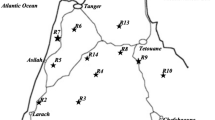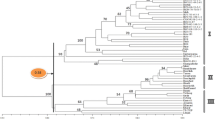Abstract
Amplified fragments length polymorphism (AFLP) was used to distinguish 20 cultivars of sesame (Sesamum indicum L.) and to elucidate the genetic relationship among these genotypes. The data were also used to estimate the usefulness of parameters currently used to assess the informativeness of molecular markers. A total of 339 markers were obtained using 8 primer combinations. Of the bands, 91% were polymorphic. Five primer combinations were able to distinguish all 20 cultivars used. None of the remaining three primer combinations could distinguish all accessions if used alone, but using all three combinations reduced the probability of a random match to 5 × 10−5. Polymorphic information content (PIC), resolving power (Rp) and marker index (MI) of each primer combination failed to correlate significantly with the number of genotypes resolved. Jaccard’s similarity coefficients ranged from 0.31 to 0.78. Fifteen cultivars were grouped by four UPGMA-clusters supported by bootstrapping values larger than 0.70. The grouping pattern was similar to the grouping generated by principal coordinate analysis. The results demonstrated that AFLP-based fingerprints can be used to identify unequivocally sesame genotypes, which is needed for cultivar identification and for the assessment of the genetic variability of breeding stocks. We recommend to use the number of cultivars identified by a primer combination instead of PIC, Rp and MI; and to calculate the maximal, instead of average probability of identical match by chance in the assessment of the informativeness of a marker for cultivar identification.


Similar content being viewed by others
References
Archak S, Gaikwad B, Gautam D, Rao E, Swamy K, Karihaloo J (2003) DNA fingerprinting of Indian cashew (Anacardium occidentale L.) varieties using RAPD and ISSR techniques. Euphytica 230:397–404
Ashri A (1998) Sesame breeding. Plant Breed Rev 16:179–228
Bohn M, Utz H, Melchinger A (1999) Genetic similarities among winter wheat cultivars determined on the basis of RFLPs, AFLPs and SSRs and their use for predicting progeny variance. Crop Sci 39:228–237
Buhariwalla HK, Jayashree B, Eshwar K, Crouch JH (2005) Development of ESTs from chickpea roots and their use in diversity analysis of the Cicer genus. BMC Plant Biol 5:16
Dangi RS, Lagu MD, Choudhary LB, Ranjekar PK, Gupta VS (2004) Assessment of genetic diversity in Trigonella foenum-graecum and Trigonella caerulea using ISSR and RAPD markers. BMC Plant Biol 4:13
De Riek J, Calsyn E, Everaert I, Van Bockstaele E, De Loose M (2001) AFLP based alternatives for the assessment of distinctness, uniformity and stability of sugar beet varieties. Theor Appl Genet 103:1254–1265
FAO (2005) FAOstat Databases. http://www.faostat.fao.org/
Fernandez M, Figueiras A, Benito C (2002) The use of ISSR and RAPD markers for detecting DNA polymorphism, genotype identification and genetic diversity among barley cultivars with known origin. Theor Appl Genet 104:845–851
Hong Y, Chuah A (2003) A format for databasing and comparison of AFLP fingerprint profiles. BMC Bioinformatics 4:7
Karp A, Kresovich S, Bhat K, Ayad W, Hodgkin T (1997) Molecular tools in plant genetic resources conservation: a guide to the technology. IPGRI Technical Bulletin No. 2. International Plant Genetic Resources Institute, Rome, Italy
Langham D, Rodriguez M (1946) Dos nuevas variedades de ajonjolí Venezuela 51 y Venezuela 52. Circular No. 15. Departamento de Genetica. Dirección de Agricultura. Maracay. Venezuela
Laurentin H, Layrisse A, Quijada P (2000) Evaluación de dos ciclos de selección recurrente para altos rendimientos de semilla en una población de ajonjolí. Agronomía Tropical (Maracay) 50:521–535
Laurentin H, Pereira C, Sanabria M (2003) Phytochemical characterization of six sesame (Sesamum indicum L.) genotypes and their relationships with resistance against whitefly (Bemisia tabaci Gennadius). Agronomy J 95(6):1577–1582
Laurentin H, Montilla D, Garcia V (2004) Relación entre el rendimiento de ocho genotipos de ajonjolí (Sesamum indicum L.) y sus componentes. Comparación de metodologías. Bioagro 16:153–162
Laurentin H, Karlovsky P (2006) Genetic relationship and diversity in a sesame (Sesamum indicum L.) germplasm collection using amplified fragment length polymorphism. BMC Genet 7:10
Mazzani B (1952) Una nueva variedad de ajonjolí producica en el Instituto Nacional de Agricultura. Agronomía Tropical (Maracay) 1:269–277
Mazzani B (1953) Inamar: nueva variedad de ajonjolí producidad en el Instituto Nacional de Agricultura. Agronomía Tropical (Maracay) 3:211–213
Mazzani B, Nava C, Martinez A, Layrisse A (1973) Maporal, una nueva variedad de ajonjoli para los Llanos Occidentales. Agronomia Tropical 23:501–508
Milbourne D, Meyer R, Bradshaw J, Baird E, Bonar N, Provan J, Powell W, Waught R (1997) Comparison of PCR-based marker systems for the analysis of genetic relationships in cultivated potato. Mol Breed 3:127–136
de Moretzsohn MC, Hopkins MS, Mitchell SE, Kresovich S, Valls JF, Ferreira ME (2004) Genetic diversity of peanut (Arachis hypogaea L.) and its wild relatives based on the analysis of hypervariable regions of the genome. BMC Plant Biol 4:11
Montilla D, Cedeño T (1991) Fonucla: una nueva variedad de ajonjolí (Sesamum indicum L.). Bioagro 3:52–54
Montilla D, Teran H (1996) UCLA1, una nueva variedad de ajonjolí (Sesamum indicum L.). Bioagro 8:26–29
Muminovic J, Melchinger A, Lübberstedt T (2004) Genetic diversity in cornsalad (Valerianella locusta) and related species as determined by AFLP markers. Plant Breed 123:460–466
Ovesná J, Poláková K, Leisová L (2002) DNA analyses and their applications in plant breeding. Czech J Genet Plant Breed 38:29–40
Powell W, Margenta M, Andre C, Hanfrey M, Vogel J, Tingey S, Rafalsky A (1996) The utility of RFLP, RAPD, AFLP and SSR (microsatellite) markers for germplasm analysis. Mol Breed 2:225–238
Prevost A, Wilkinson M (1999) A new system of comparing PCR primers applied to ISSR fingerprinting of potato cultivars. Theor Appl Genet 98:107–112
Rajora O, Rahman M (2003) Microsatellite DNA and RAPD fingerprinting, identification and genetic relationships of hybrid poplar (Populus × canadensis) cultivars. Theor Appl Genet 106:470–477
Ramakrishna W, Lagu M, Gupta V, Ranjekar P (1994) DNA fingerprinting in rice using oligonucleotide probes specific for simple repetitive DNA sequences. Theor Appl Genet 88:402–406
Rao N (2004) Plant genetic resources: advancing conservation and use through biotechnology. Afr J Biotechnol 3:136–145
Reineke A, Karlovsky P (2000) Simplified AFLP protocol: replacement of primer labeling by the incoporation of α-labeled nucleotides during PCR. BioTechniques 28:622–623
Roldán-Ruiz I, Dendauw J, VanBockstaele E, Depicker A, De Loose M (2000) AFLP markers reveal high polymorphic rates in ryegrasses (Lolium spp.). Mol Breed 6:125–134
Salazar B, Laurentin H, Dávila M, Castillo M (2006) Reliability of the RAPD technique for germplasm analysis of sesame (Sesamum indicum L.) from Venezuela. Interciencia 31:456–460
Savelkoul P, Aarts H, DeHaas J, Dijkshoorn L, Duim B, Otsen M, Rademaker J, Schouls L, Lenstra J (1999) Amplified-fragment length polymorphism analysis: the state of an art. J Clin Microbiol 37:3083–3091
Stodart B, Mackay M, Raman H (2005) AFLP and SSR analysis of genetic diversity among landraces of bread wheat (Triticum aestivum L. em. Thell.) from different geographic regions. Aust J Agric Res 56:691–697
Tams S, Melchinger A, Bauer E (2005) Genetic similarity among European winter triticale elite germplasm assessed with AFLP and comparisons with SSR and pedigree data. Plant Breed 124:154–160
Voss P, Hogers R, Bleeter M, Reijans M, van de Lee T, Hornes M, Frijters A, Pot J, Peleman J, Kuiper M, Zabeau M (1995) AFLP: a new technique for DNA fingerprinting. Nucleic Acids Res 23:4407–4414
Wetton J, Carter R, Parkin D, Walters D (1987) Demographic study of a wild house sparrow population by DNA fingerprinting. Nature 327:147–149
Zhang LH, Ozias-Akins P, Kochert G, Kresovich S, Dean R, Hanna W (1999) Differentiation of bermudagrass (Cynodon spp.) genotypes by AFLP analysis. Theor Appl Genet 98:895–902
Acknowledgements
This work was supported by the Programme Alban, European Union Programme of High Level Scholarships for Latin America, Identification Number E03D13301VE, International PhD program for Agricultural Sciences in Göttingen University (IPAG) and Universidad Centroccidental Lisandro Alvarado.
Author information
Authors and Affiliations
Corresponding author
Rights and permissions
About this article
Cite this article
Laurentin, H., Karlovsky, P. AFLP fingerprinting of sesame (Sesamum indicum L.) cultivars: identification, genetic relationship and comparison of AFLP informativeness parameters. Genet Resour Crop Evol 54, 1437–1446 (2007). https://doi.org/10.1007/s10722-006-9128-y
Received:
Accepted:
Published:
Issue Date:
DOI: https://doi.org/10.1007/s10722-006-9128-y




